

A tomb effigy (French: gisant ("lying")) is a sculpted effigy of a deceased person usually shown lying recumbent on a rectangular slab.[1] Although these funerary and commemorative reliefs were first developed in Ancient Egyptian and Etruscan cultures, they appear most numerously in Western Europe tombs from the later 11th century, in a style that continued in use through the Renaissance and early modern period, and are still sometimes used. They typically represent the deceased in a state of "eternal repose", with hands folded in prayer, lying on a pillow, awaiting resurrection with a dog or lion at their feet. A husband and wife may be depicted lying side by side.
The life-size recumbent effigy was first found in the tombs of royalty and senior clerics, and then spread to the nobility. A particular type of late medieval effigy was the transi, or cadaver monument, in which the effigy is in the macabre form of a decomposing corpse, or such a figure lies on a lower level, beneath a more conventional effigy. Mourning or weeping figures, known as pleurants were added to important tombs below the effigy. Non-recumbent types of effigy became popular during the Renaissance. In the early Modern period, European effigies are often shown as alive, and either kneeling or in a more active pose, especially for military figures. Variations showed the deceased lying on their side as if reading, kneeling in prayer and even standing. The recumbent effigy had something of a revival during the 19th century Gothic revival, especially for bishops and other clerics.
Some of the best-known examples of the form are in Westminster Abbey in London, Saint Peter's in Rome, Santi Giovanni e Paolo, Venice (twenty-five Doges), and the Basilica of Santa Croce, Florence.
Antiquity
Egyptian
The religious beliefs of the societies that produced the earliest Egyptian effigies (which date to c. 2700–2200 BC, during Old Kingdom) are unknown, but are usually assumed by modern archeologists to have commerated either fallen Gods or members of royalty.[2]
Because these burial practices are prehistoric, their meaning can only be guessed at: modern archeologists see them as depictions intended to house the souls of the dead, intended to identify them as they travel through the realm of the dead.[2] The earliest known tomb effigy is that of Djoser (c. 2686–2613 BC), whose effigy was found in the worship chamber of an Egyptian pyramid. Usually the effigies were smaller than life-size.
The Romans continued this tradition of idolatry, though they created many other types of effigies. Their faces are often clearly portraits of individuals.
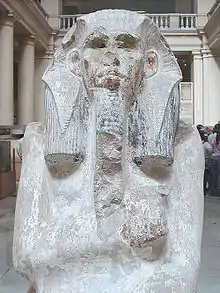
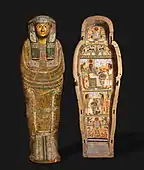
 Replicas of the coffins of Tutankhamun, 1355–134 BC. The originals are in the Egyptian Museum, Cairo, Egypt
Replicas of the coffins of Tutankhamun, 1355–134 BC. The originals are in the Egyptian Museum, Cairo, Egypt
Late Classical and Hellenistic
Recumbent effigies were a common tradition in the funerary art of the Etruscans, an advanced civilization and culture that developed in central Italy before 700 BC and flourished until the late second century BC.[4] Their effigies were typically carved in high relief,[4] and produced in a variety of materials, including ceramic, terracotta, marble, limestone and alabaster.[5] Structurally they fall into two categories: small squarish cinerary urns for cremation and near life-sized rectangular sarcophagi for burials, with cremation becoming more popular over the centuries.[5][6] Etruscan culture viewed the dead as no less completed than the living, and existing in a realm where they were forever in despair or forever enjoying material comforts.[5] From 500 BC the effigies perpetuated the memory of the deceased as they looked while alive, often lavishly dressed, and shown enjoying food and drink as if at a feast. They are typically shown as reclining (as if alive) rather than recumbent (as if dead), with open eyes turned towards the viewer, and often propped on a pillow and leaning on their arm or elbow.[7]
By the 7th century the Etruscans were depicting human heads on canopic urns. When they started to bury their dead in the late 6th century they used terracotta sarcophagi,[8] with an image of the deceased reclining on the lid alone or with a spouse.[8] The Etruscan's style influenced late Ancient Greek, especially in the manner of showing the dead as they had been in life, typically in the stele (stone or wooden slabs usually built as funerary markers) format.[9] Any aspects of the style were adapted by the Romans, and eventually spread as far as Western Asia.[7]
 Sarcophagus of the Spouses, 530–510 BC. National Etruscan Museum, Rome, Italy
Sarcophagus of the Spouses, 530–510 BC. National Etruscan Museum, Rome, Italy Sarcophagus in the Villa Corsini, Florence. 300-275 BC
Sarcophagus in the Villa Corsini, Florence. 300-275 BC Funerary urn, c. 210–90 BC. Museo archeologico nazionale Siena, Italy
Funerary urn, c. 210–90 BC. Museo archeologico nazionale Siena, Italy Sarcophagus of Seianti Hanunia Tlesnasa, c. 150–130 BC. Painted terracotta, British Museum, London
Sarcophagus of Seianti Hanunia Tlesnasa, c. 150–130 BC. Painted terracotta, British Museum, London
Pre-historic Romans of Palatine Hill often cremated their dead (usually on pyres), while those of the Quirinal Hill would entomb the body. Eventually the two practices merged, wherein the actual body was entombed and an effigy of the deceased was burned.[5] The Romans adopted the Etruscan's tomb formats, maintaining the practice of showing the deceased as they were while alive. Roman sarcophagi were built from marble, and over time took on a more a contemplative, spiritual and redemptive iconographical tone, emphasising the deceased's former hierarchical role in society.[10]
Medieval
Origin and characteristics

The first recumbent Medieval effigies (or gisants) were produced in the 11th century, with the earliest surviving example being that of Rudolf of Swabia (d. 1080) in Merseburg Cathedral.[11] The early effigies show the deceased (usually a royal, senior cleric or aristocrat) dressed in contemporary clothing. The format proliferated across Northern Europe in the late 12th century as it become popular amongst a growing class of wealthy elites who typically commissioned their tombs years before their death; often seeking to cement their historical or spiritual legacy, or —especially in early examples— restore a reputation tarnished by political defeat.[12][13]
The art historian Marisa Anne Bass summed up the function of Medieval effigies by writing that "to represent death is to make present an absence."[14] Historians differ as to the historical influences behind their designs. Writing in 1964, in the first major general survey of tomb sculptures, Erwin Panofsky believed they were based on mosaic from North African and Spanish tombs, with other art historians arguing that the primary influence was from Classical funerary monuments, particularly those from Etruscan culture.[15] The historian Shirin Fozi recognises the influence of earlier formats, but believes that the idea of placing an "enlivened" representation of the dead above their grave is "too intuitive and too obvious to be read that ancient analogues were necessarily sources of inspiration."[16]
Medieval effigies are typically built from marble, alabaster or wood. According to the English historian Alfred C. Fryer, a "hastily made and lively effigy" of the deceased "in his very robes of estate" became part of the funeral procession, after which the representation was left either above or near the burial spot.[17] They were place on many types of tombs; at first on tomb slabs, before table or chest tombs (tumba) became the standard.[18] Later, wall tombs became popular in France and Spain.[19]
Chest tombs were typically built from several stone panels, and provided a cavity (often filled with rubble) to support the effigy. Although they were designed to give the impression that the body had been placed within it, the corpse was usually buried in a vault below or beside the monument. Recent excavations indicate that some 14th century chests did act as containers for the body, however relatively few medieval tomb monuments have been opened.[20] Notable examples where the body was placed inside the chest include the tombs of Henry III of England (completed c. 1290) and Edward I (d. 1307), both in Westminster Abbey, London. When the latter tomb was opened in 1774, the remains were found in a marble coffin placed on a bed of rubble.[21]
Romanesque
The earliest Medieval examples are German,[22] but the style was significantly developed by French sculptors in the Romanesque style between c. 1080 and c. 1160.[23] By the 12th century, the German, Dutch, Belgian, Spanish effigies were following the forms and iconography of the French models,[24][23] and had begun to adapt elements of the emerging Gothic style.[25]
The Romanesque effigies were typically carved from white marble, and depict the deceased's body and face as they appeared as in life, with no marks of illness or death. The faces are idealised rather than accurate portrayals, and often show the deceased much younger than they had been at death.[26] The effigies are always recumbent—as if dead, and by the 14th century with hands clasped in prayer. The most common material is carvings on marble, alabaster or wood, with some examples cast in bronze or brass. The faces and hands of the wooden effigies, of which very few survive, are made from wax or plaster.[27] The effigies were usually polychromed to simulate life, but in most cases this paint has long since worn away.
The first secular effigies appear in the early 13th century with the establishment of the patron class of knight.[28] These effigies were usually placed on flat marble slabs, supported by tomb-style chests (also known as tumba)[9] decorated with foliage, heraldry and architectural detailing. The earliest examples wearing armor date from the 1240s, with the most numerous surviving examples in England. The two most common poses from these types are the knight pulling out his sword, or lying cross-legged—a particularly English motif.[29]
While the original Romanesque and later Gothic tombs were produced in great numbers –especially in England and France– it is estimated that over half were destroyed during the waves of iconoclasm in the early modern period, and during the French revolution.[24]
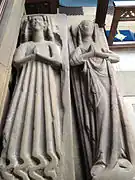 Effigies in St John the Baptist, Tideswell, Derbyshire, England. 12th and 13th centuries
Effigies in St John the Baptist, Tideswell, Derbyshire, England. 12th and 13th centuries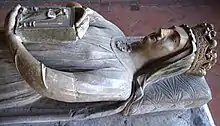 Effigy of Berengaria of Navarre (d. 1230). L'Épau Abbey, France
Effigy of Berengaria of Navarre (d. 1230). L'Épau Abbey, France.JPG.webp) Tomb effigy of Jean d'Aluye (foreground), French, 13th century. Now in The Cloisters, New York[30]
Tomb effigy of Jean d'Aluye (foreground), French, 13th century. Now in The Cloisters, New York[30]%252C_crypte_St-Paul%252C_tombeau_de_sainte_Osanne%252C_XIIIe_si%C3%A8cle_2.jpg.webp) Tomb of Ozanne, 13th century. Crypte Saint-Paul, Jouarre Abbey, France.
Tomb of Ozanne, 13th century. Crypte Saint-Paul, Jouarre Abbey, France.
Britain

Tomb effigies are the most numerous type of surviving British medieval statuary, and although England also underwent periods of iconoclasm, their number exceeds even that of France. Many of the 11th- and early 12th-century effigies are known as "dying Gauls" due to the common motif of the deceased (always a Knight) shown as reaching for his sword as if struggling against death or about to enter battle. Tombs for these centuries are sometimes smaller than life-sized, and the armoured or knightly examples often show the deceased with their legs crossed.[31][32]
The larger-scale production of British effigies began in the middle of the 13th century as the result of the creation of a new patron class of knights.[33] A great number of ecclesiastical effigies were also produced in this period, but a majority were destroyed during the iconoclasm waves and the later Cromwellion Wars of the Three Kingdoms.[28] Today, there are over 150 extant 13th-century English knightly effigies and around 200 from the 14th century.[29]
Compared to French examples, the effigies of 13th-century English knights are less rigid and statuesque, and thuis reflect a "more worldly and less spiritual outlook".[24] Three 13th-century solid oak examples survive: in Pitchford (for John de Pitchford), Westminster Abbey (for William de Valence) and Salisbury Cathedral (for William Longespée).[34]
The cross-legged pose of many 13th- or early 14th-century English effigies was long supposed to imply that the deceased had served in the Crusades, had taken crusading vows, or more specifically had been a Knight Templar; but these theories are now rejected by scholars.[35]



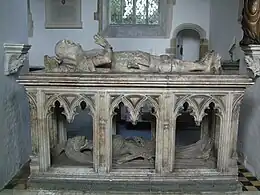 The tiered monument for John FitzAlan, alabaster and limestone, c. 1435–45. Note the transi in the lower register.[38] Arundel Castle, West Sussex
The tiered monument for John FitzAlan, alabaster and limestone, c. 1435–45. Note the transi in the lower register.[38] Arundel Castle, West Sussex
Double tombs

The practice of showing the effigies of a married couple side by side on the same plinth or slab began in 13th century England in a format that soon spread across northern Europe.[39] Before this couples were given monuments, often linked within a unified overall structure.[40]
Prominent late 14th and early 15th century examples show the couples holding hands. The practice may have begun as a device for legitimising controversial or contested royal marriages; in the case of Blanche of Lancaster, she was already married at the time of her union with John of Gaunt.[41] In the same way, the early gothic double toms should not be interpreted through the modern concept of love and emotions; instead they were intended to reinforce the political aspect of the couple's union, and to elicit intercessory prayer.[42]
An early example is the now lost tomb for Blanche of Lancaster (d. 1368) and her second husband John of Gaunt (d. 1399). The celebrated Philip Larkin's poem An Arundel Tomb (1964) describes and reflects on a pair of stone effigies for Richard Fitzalan (d. 1376) and Eleanor of Lancaster (sister of Blanche, d. 1372) in Chichester Cathedral.[41][43]
Cadaver monuments (Transi)
_(cropped).jpg.webp)
The style of showing the deceased as a decomposing corpse began in France in the late 14th century. The first known English example dates to 1425[lower-alpha 1] and soon after the style spread across other parts Northern Europe.[45][44] Known as cadaver monuments (French: Transi),[lower-alpha 2] the effigies show the deceased as an emaciated corpse with closed eyes, either wearing a shroud or naked (although with their hands arranged to preserve modesty), and sometimes standing upwards. The format is in stark contrast to gisants, which are always recumbent, in full dress, with open eyes and hands clasped and raised in prayer.[47][48] Their production was overseen by the first rank of contemporary sculptors, including Conrad Meit (d. c. 1550),
Cadaver monuments first appear in the 1380s and remained popular for 200 years.[49] Often interpreted (in a theory popularised by the historians Helen M. Roe and John Aberth which is still widely debated)[50] as a form of memento mori or adaption of the motif of "The Three Living and the Three Dead", they show the human body's "transition" from life to decomposition,[51] highlighting the contrast between worldly riches and elegance and the degradation of death.[48] An illuminated c. 1435–1440 miniature of a Lady in a Tomb from "The Dawnce of Makabre" foilios in the Additional manuscript 37049 (now in the British Library shows the tiered (double or "two–body")[52] tomb of a fashionable English lady, with her shown in-life above the slab, and as decayed corpse within the tomb chest. Verse below the illustration reads: "Take hede un to my fygure here abowne, And se how sumtyme I was fresche and gay, Now turned to wormes mete and corrupcoun, Bot fowle erthe and stynkyng slyme and clay".[38] However, the art historian Kathleen Cohen notes some important differences to memento mori, primarily that Transi represent specific deceased individuals, and not death itself.[53]
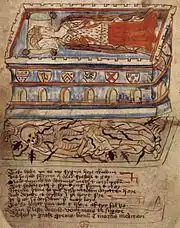
Cadaver monuments were a dramatic change from the typical practice of depicting the deceased as either as in life or in a more idealised form. The impulse toward graphic expression of mortality in part reflects the societal shock and trauma following the Black Death which hit Europe in 1346 and killed up to half of the population of Eurasia in the next four years. It's aftermath saw, in 15th and 16th century literature, painting, manuscript illustration and sculpture, a pronounced emphasis on the macabre and memento mori, indicating a pre-occupation with the brevity and fragility of human life.[55][56]
Other influencing factors over time include, according to Cohen, "the attempt to humiliate the body in order to gain salvation, the desperate desires for prayers for the soul ... [and] ... contemporary ... resurrection symbolism".[57]
In her (incomplete but representative) 1973 survey of extant cadaver monuments, the art historian Kathleen Cohen lists 200 examples, of which 82 are English (produced between 1424–1689), 61 are French (produced 1391–1613), 36 are German (1456–1594), and 20 are in the Lowlands (1387–1645).[58] Considerable differences in style developed across regions and time. The early examples show the deceased either covered in a shroud (popular in France, Burgundy and England), as a shriveled corpse with tightly pulled skin (especially popular in England), or a decomposing body covered by frogs and snakes (Germany and Austria). The practice of showing the body crawling with worms became popular in France.[59]
Over the centuries the depictions became more realistic and gruesome, while the early tendency to line the tombs with moralising inscriptions on the vanities of life was abandoned. The format reaching a peak in the late 16th century, with the more extreme effigies depicting putrefied corpses outside of the funerary monument context, and taking center stage as stand-alone sculptures.[45]
 The early and influential Cadaver Tomb of Guillaume de Harsigny, a French doctor and court physician to Charles V of France, c. 1394. Musée d'art et d'archéologie de Laon, France[60]
The early and influential Cadaver Tomb of Guillaume de Harsigny, a French doctor and court physician to Charles V of France, c. 1394. Musée d'art et d'archéologie de Laon, France[60].jpg.webp)
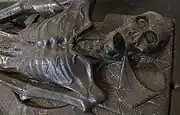 Transi of Guillaume Lefranchois, 1446, Musée des beaux-arts d'Arras, France
Transi of Guillaume Lefranchois, 1446, Musée des beaux-arts d'Arras, France Tomb of John Baret (d 1467), St Mary's Church, Bury St Edmunds, England
Tomb of John Baret (d 1467), St Mary's Church, Bury St Edmunds, England
Court of Burgundy
_-_Mus%C3%A9e_des_Beaux-Arts_-_Tombeaux_des_ducs_de_Bourgogne_(c%C3%A9notaphe_de_Philippe-le-Hardi)_(14773660169).jpg.webp)
The dukes of Burgundy were recognised throughout Europe as patrons of the arts, who through their cultivation of artists such as the sculptor Claus Sluter and the painters Jan van Eyck and Rogier van der Weyden (Rogier is thought to have painted some of the effigies), became key in the development of Early Netherlandish art and the wider Northern Renaissance.[61]
The iconography of Burgundian tombs develops forms and motifs found on monuments for French Kings in the Basilica of Saint-Denis, near Paris.[62] Although the now lost tomb of Joan of Brabant (c. 1457) is probably the earliest of the tombs,[63] the style became influential across Europe with the tomb of Philip the Bold (d. 1404), built over 30 years from 1381[64] by the sculptors Jean de Marville (d. 1389) and Sluter (d. 1405?) for the Chartreuse de Champmol, outside Dijon, which also houses the tombs of his son John the Fearless (d. 1419) and John's wife Margaret of Bavaria (d. 1424).[65][66] Philip's tomb is described by the art historian Frits Scholten as "one of the most magnificent tombs of the Late Middle Ages".[66]
The effigies on Burgundian-style tombs are characteristised by the deceased having naturalised faces, open eyes, angels above their heads, and animals (that may be dogs or lions) at their feet.[63] Philip's is made from polychromed white marble which gives him a more naturalised pallor. His head rests on a cushion and he has an angel at each side to watch over him, presumably guiding him into the afterlife. His open eyes are intended as an affirmation of his belief in the Resurrection, as are the prayers mouthed or in the books held by some of the weepers in the niches below the tomb monument's oblong chest.[67]
.jpg.webp) Isabella of Bourbon's effigy (1475–1476) displayed with its 10 surviving pleurants
Isabella of Bourbon's effigy (1475–1476) displayed with its 10 surviving pleurants..jpg.webp)
_(cropped).jpg.webp) Tomb of Charles the Bold (d. 1477) with Mary of Burgundy in background, Church of Our Lady, Bruges[69]
Tomb of Charles the Bold (d. 1477) with Mary of Burgundy in background, Church of Our Lady, Bruges[69]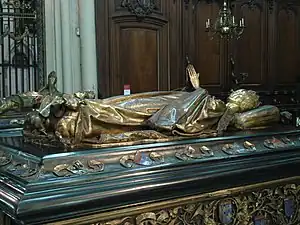 Tomb of Mary of Burgundy, 1501. Church of Our Lady, Bruges
Tomb of Mary of Burgundy, 1501. Church of Our Lady, Bruges
Renaissance
While many of the innovations in medieval tomb effigies occurred in Northern Europe, the influence of Renaissance sculpture on medieval developed in the early fifteenth century in Italy and later in Spain.[19] While the structural format of the tombs stayed largely faithful to the earlier Romanesque and Gothic traditions, the iconography began to reflect societal shift in attitude towards the dead; particularly in the incorporation of secular and humanistic imagery. The architectural settings became more elaborate, incorporating architectural elements such as putto and ancient decorative elements including sirens, centaurs and Roman style profile heads.[70] The tombs and their effigies incorporated and merge recent sculptural and painterly innovations with classical traditions.[19]
Most significantly, non-recumbent effigies became more popular, with variations including the deceased lying upwards on their side, kneeling in prayer, or even standing. The upper portion of the Tomb of Valentina Balbiani (d. 1572) shows her in-life, with a book and dog, reclining in a restful pose reminiscent of Etruscan effigies. A bas-relief on the tomb's base shows her decomposed corpse in the transi style.[71]
A number of old masters were involved in the tomb and effigy's design and construction, including Albrecht Dürer (as an influence),[70] while artists such as Donatello and Bernini oversaw their design and execution.[72]
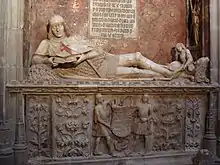 Tomb of Martín Vázquez de Arce (d. 1486}, Sigüenza Cathedral, Spain
Tomb of Martín Vázquez de Arce (d. 1486}, Sigüenza Cathedral, Spain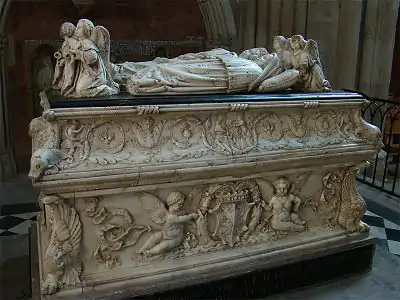
 Tomb of Valentina Balbiani, Germain Pilon, c. 1580. Louvre, Paris
Tomb of Valentina Balbiani, Germain Pilon, c. 1580. Louvre, Paris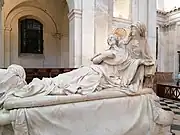 A baroque elaboration: the tomb of Cardinal Richelieu (d. 1642), c. 1675–94. Chapel of the Sorbonne, Paris, France
A baroque elaboration: the tomb of Cardinal Richelieu (d. 1642), c. 1675–94. Chapel of the Sorbonne, Paris, France
Modern
During the early modern period, the style and form of tomb monuments adapted innovations from other forms of sculpture, including from non European influences, while also incorporating elements of local traditions in memorial sculpture.[14]
The recumbent effigy returned to vogue during the 19th century Gothic revival period, especially for clerics. Many graves at Monument Cemetery in Milan have recumbent figures.
_(cropped).jpg.webp)
 Tomb of Francesc Farreras i Framis, 1888. Montjuïc Cemetery, Barcelona, Spain
Tomb of Francesc Farreras i Framis, 1888. Montjuïc Cemetery, Barcelona, Spain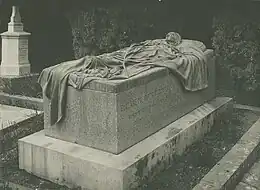
_Gisante_cimetiere_Carnot_Suresnes.JPG.webp) Tomb of Augustine Trochery (1856–1887), Cimetière Carnot, Suresnes, France
Tomb of Augustine Trochery (1856–1887), Cimetière Carnot, Suresnes, France
Footnotes
References
- ↑ Lucie-Smith, Edward (1984), The Thames and Hudson Dictionary of Art Terms, Thames and Hudson, p. 89
- 1 2 Panofsky (1964), p. 9
- ↑ "Coffin of Nesykhonsu c. 976–889 BC". Cleveland Museum of Art. Retrieved 28 April 2023
- 1 2 Hemingway, Colette; Hemingway, Seán. "Etruscan Art". NYC: Metropolitan Museum of Art, October 2004. Retrieved 5 May 2023
- 1 2 3 4 Panofsky (1964), p. 28
- ↑ Turfa (2005), p. 55
- 1 2 Panofsky (1964), p. 29
- 1 2 Ramage (2009), p. 51
- 1 2 Panofsky (1964), p. 27
- ↑ Panofsky (1964), p. 30
- ↑ Fozi (2015), p. 158
- ↑ Fozi (2021), p. 12
- ↑ Bass (2017), pp. 163, 181
- 1 2 Bass (2017), p. 162
- ↑ Fozi (2021), p. 6
- ↑ Fozi (2021), p. 13
- ↑ Fryer (1909), p. 18
- ↑ Panofsky (1964), pp. 24, 53
- 1 2 3 Panofsky (1964), p. 67
- ↑ Barker (2016), pp. 117–119
- ↑ Barker (2016), p. 120
- ↑ Tummers (1980), p. 3
- 1 2 Fozi (2021), p. 2
- 1 2 3 Tummers (1980), p. 2
- ↑ Fozi (2021), pp. 2, 4
- ↑ Fozi (2021), p. 1
- ↑ Fryer (1909), pp. 18–19
- 1 2 Tummers (1980), p. 4
- 1 2 Dressler, (2000), p. 91
- ↑ "A Knight of the d'Aluye Family". Metropolitan Museum of Art. Retrieved 10 May 2023
- ↑ Tummers (1980), pp. 1–2
- ↑ Panofsky (1964), p. 56
- ↑ Stone (1972), p. 114
- ↑ Tummers (1980), p. 30
- ↑ Harris (2010), pp. 401–40
- ↑ Barker, Jessica; Mcarthur, Graeme; Pegues, Emily. "Fully armed in plate of war’: making the effigy of the Black Prince". The Burlington Magazine, 19 October 2021
- ↑ Norman, A. "The Effigy of Alexander Stewart, Earl of Buchan and Lord of Badenoch (?1343 - ?1405)". Proceedings of the Society of Antiquaries of Scotland, volume 92, 1961. pp. 104–113
- 1 2 Barker (2016), p. 115
- ↑ Barker (2020), p. 4
- ↑ Barker (2020), p. 31
- 1 2 Barker (2020), p. 6
- ↑ Barker (2020), pp. 11, 16
- ↑ Tummers (1988), pp. 31–36
- 1 2 Welch (2013), p.135
- 1 2 Bass (2017), p. 163
- ↑ Heimerman (2021), pp. 3–4
- ↑ Cohen (1974), p. 9
- 1 2 Covi (1975), p. 385
- ↑ Heimerman (2021), p. 3
- ↑ Heimerman (2021), p. 7
- ↑ Cohen (1974), p. 179
- ↑ Bass (2017), p. 166
- ↑ Cohen (1974), p. 10
- ↑ "Add MS 37049". British Library. Retrieved 1 June 2023
- ↑ Heimerman (2021), p. 6
- ↑ Roe (1969), p. 1
- ↑ Cohen (1974), p. 4
- ↑ Welch (2013), p.134
- ↑ Cohen (1974), p. 2
- ↑ Heimerman (2021), p. 8
- ↑ Lee Reid, Katerrine. In the preface to Antoine (2005)
- ↑ Jugie (2010), p. 39
- 1 2 Jugie (2010), p. 51
- ↑ Antoine (2005), p. 419
- ↑ Nash (2008), pp. 262–263
- 1 2 Scholten (2007), p. 14
- ↑ Jugie (2010), p. 31
- ↑ Jugie (2019), p. 47
- ↑ "The effigies of Mary of Burgundy and Charles the Bold 1641". Royal Collection Trust. Retrieved 27 May 2023
- 1 2 Panofsky (1964), p. 68
- ↑ Panofsky (1964), p. 81
- ↑ Panofsky (1964), p. 68–78
- ↑ Panofsky (1964), p. 76
- ↑ "Tomb Effigy of Elizabeth Boott Duveneck". Metropolitan Museum of Art. Retrieved 28 April 2023
Sources
- Antoine, Elisabeth. Art from the Court of Burgundy: The Patronage of Philip the Bold and John the Fearless, 1364-1419. Seattle (WA): University of Washington, 2005. ISBN 978-2-7118-4864-5
- Barker, Jessica. Stone Fidelity: Marriage and Emotion in Medieval Tomb Sculpture. London: Boydell Press, 2020. ISBN 978-1-7832-7271-6
- Barker, Jessica. Revisiting The Monument: Fifty Years since Panofsky’s Tomb Sculpture. London: Courtauld Institute of Art, 2016. ISBN 978-1-9074-850-6-0
- Bass, Marisa Anne. "The transi tomb and the genius of sixteenth century Netherlandish funerary sculpture". Netherlands Yearbook for the History of Art, volume 67, 2017. JSTOR 26593102
- Binski, Paul. Medieval Death: Ritual and Representation. London: British Museum Press, 2001. ISBN 978-0-7141-0561-1
- Cohen, Kathleen. Metamorphosis of a Death Symbol: The Transi Tomb in the Late Middle Ages and the Renaissance. Los Angeles: University of California Press, 1973. ISBN 978-0-5200-1844-0
- Covi, Dario. "Reviewed Work(s): Metamorphosis of a Death Symbol: The Transi Tomb in the Late Middle Ages and the Renaissance. by Kathleen Cohen". Renaissance Quarterly, volume 28, No. 3, Autumn 1975. JSTOR 2859829
- Dressler, Rachel. "Cross-legged Knights and Signification in English Medieval Tomb Sculpture". Studies in Iconography, volume 21, 2000. JSTOR 23924216
- Fozi, Shirin. Romanesque Tomb Effigies: Death and Redemption in Medieval Europe, 1000–1200. University Park (PA): Penn State University Press, 2021. ISBN 978-0-2710-8917-1
- Fozi, Shirin. "Reinhildis Has Died": Ascension and Enlivenment on a Twelfth-Century Tomb. Speculum, volume 90, no. 1, January 2015. JSTOR 43577275
- Fryer, Alfred Cooper. "Wooden Monumental Effigies In England And Wales". London: Archaeologia or Miscellaneous Tracts relating to Antiquity, 1909, republished 1924
- Harris, O. D. "Antiquarian attitudes: crossed legs, crusaders and the evolution of an idea". The Antiquaries Journal, volume 90, 2010
- Hebblethwaite, Rob. "The Good, the Bad and the Rotten: How the Living Dealt With the Dead in England c.600-1200". PhD thesis, University of East Anglia, 2017
- Heimerman, Emily. "A Portrait of Death: Analyzing the Transi Tomb of Guillaume de Harcigny (1300-1393 A.D.)". Coalition of Master’s Scholars on Material Culture, April 2, 2021
- s'Jacob, Henriette. Idealism and Realism: A Study of Sepulchral Symbolism. University of Michigan: E.J. Brill, 1954
- Jugie, Sophie. Le Tombeau de Philippe Pot. Paris: Ediciones El Viso, 2019. ISBN 978-8-4948-2447-0
- Jugie, Sophie. The Mourners: Tomb Sculpture from the Court of Burgundy. New Haven (CT): Yale University Press, 2010. ISBN 978-0-3001-5517-4
- Cohen, Kathleen. The Changing Meaning of the Transi Tomb in Fifteenth and Sixteenth-Century Europe. Berkeley and Los Angeles (CA): University of California Press, 1968
- Panofsky, Erwin. Tomb Sculpture: Four Lectures on its Changing Aspects from Ancient Egypt to Bernini. London: Harry Abrams, 1964. ISBN 978-0-8109-3870-0
- Ramage, Nancy; Ramage, Andrew. Roman Art: Romulus to Constantine. NJ: Pearson Prentice-Hall, 2009
- Roe, Helen. "Cadaver Effigial Monuments in Ireland". Journal of the Royal Society of Antiquaries of Ireland, volume 99, No. 1, 1969. p. 4. JSTOR 25509699
- Rushforth, G. McN. Funeral Lights in Roman Sepulchral Monuments. Journal of Roman Studies, volume 5, 1915. JSTOR 296303
- Smith, Jeffrey Chipps. The Northern Renaissance. London: Phaidon Press, 2004. ISBN 978-0714838670
- Stone, Lawrence. Sculpture in Britain: The Middle Ages. Penguin Books, 1972. ISBN 978-0-3000-5300-5
- Tummers, H.A. "The medieval effigial tombs in Chichester Cathedral". Church Monuments, volume 3, 1988
- Tummers, H.A. Early Secular Effigies in England: The Thirteenth Century. Leiden: Brill Archive, 1980. ISBN 978-9-0040-6255-9
- Turfa, Jean Macintosh. Catalogue of the Etruscan Gallery of the University of Pennsylvania Museum of Archaeology and Anthropology. Philadelphia (PA): University of Pennsylvania Press, 2005. ISBN 978-1-9317-0752-7
- Welch, Christina. "Depicting Death in Late-medieval British funerary sculpture; English and Welsh carved cadavers, c1420/5-1588". Mourning & Morbidity: British Death and Art, University of York, 10 March 2015
- Welch, Christina. "For Prayers and Pedagogy: Contextualising English Carved Cadaver Monuments of the Late-Medieval Social and Religious Elite". Fieldwork in Religion, Equinox Publishing, 2012
External links
- The Royal Tombs of England with Prof. Aidan Dodson, the Churches Conservation Trust, 2021 (video on YouTube).